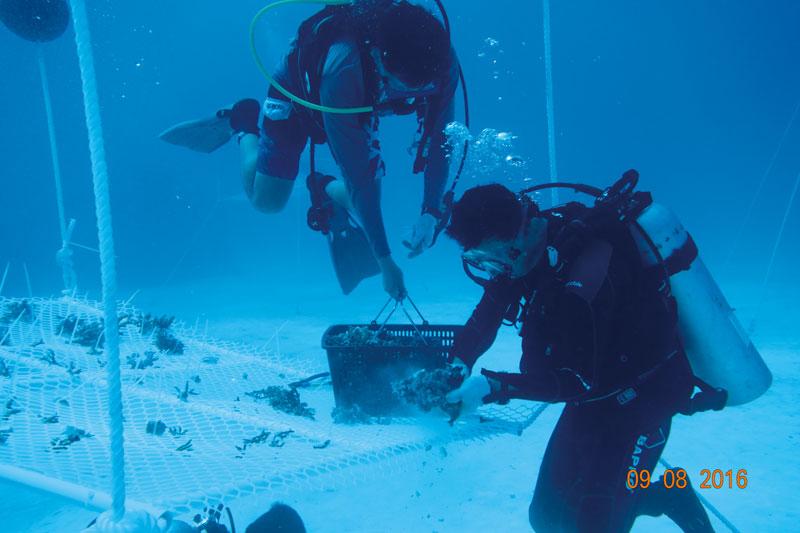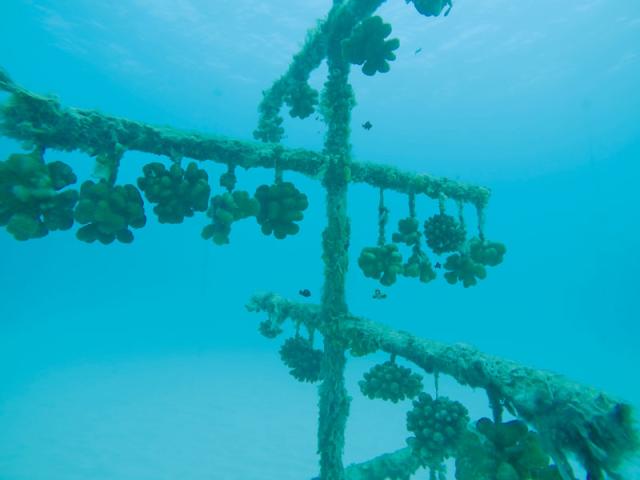The distribution and healthy growth of coral and reefs is a significant indicator of healthy ocean ecology. Only pristine ocean environments allow the special interaction between coral polyps and planktons that produce a coral reef.
Coral reefs are the habitat for a wide range of marine life. A good analogy goes like this: the significance of a coral reef to ocean ecology is comparable to the significance of forests to mountain ecology. The function of forests is obvious; to prevent erosion and stabilise soil and preserve wildlife – without forests, mountains are bare land.
Coral reefs are described as the rainforest of the sea. They can effectively prevent beach erosion by waves, as well as offering a breeding ground for marine life. Of the total global seabed of some 360 million square kilometres, coral reefs cover just 0.2 percent. Despite that, they provide shelter for a quarter of the ecology of the ocean.
They are hosts to a huge number of associated fauna, and the loss of any particular type coral could bring about the demise of an entire species. Economic activities including fishing, oil and gas extraction, tourism and more are all closely enmeshed in the existence of coral reefs.
Research revealed in an article titled “The Wicked Problem of China’s Disappearing Coral Reefs,” authored by Huang Hui and scientists from James Cook University in Australia, that “coral abundance has declined by at least 80 percent over the past 30 years on coastal fringing reefs along the Chinese mainland and adjoining Hainan Island.” The coral reefs of the South China Sea region are thought to be the eighth-biggest in the world, 2.57 percent of the global total.
Professor Huang Hui clearly remembers the first time she went to Yongxing Island in the Xisha Islands to conduct reef-related fisheries research back in 2002.
“The Xisha Islands area was a real paradise back then,” Professor Huang told ChinaReport, adding that it was easy to see the seabed clearly from the boat and the most densely distributed coral area covered more than 90 percent of the area. She described the view of dancing coral in rich colours, swarms of fish in between outcrops of coral and turtles ambling along the seabed. Fishermen could harvest an average of five metric tons of sea cucumber per day.
“Even the early 2000s was not the most pristine time for the Xisha Islands, and now the situation is worse and the place is ruined,” Huang said. Over the past two decades, due to reasons that include climate change, the proliferation of predators, marine pollution, overfishing and excessive harvesting of coral resources, coral coverage in the South China Sea region has been depleted by up to 80 percent. “The fact we have so much work to do just indicates the massive scale of the problem.”
Climate change can lead to a rise in ocean temperature that causes coral to die. An El Niño event in 1997-1998 caused approximately 16 percent of the world’s coral reefs to bleach. Some areas suffered 10 months of rising temperatures. And in the Maldives, between March and May 2016, around 73 percent of coral reefs suffered bleaching.
In 2017, marine biologist Julia Baum of Canada’s University of Victoria said that even if the world was able to halt climate change today, scientists still expected more than 90 percent of the world’s coral would die by 2050. Without drastic intervention, she warned, we risk losing all of it.
Wang Xiaoqiang from the State Oceanic Administration said biodiversity and the environment in the South China Sea region have suffered serious destruction and degradation.
“Compared to the 1970s, the overall area covered by coral reefs is down 80 percent in that region.”
This was the context in which the global community started to conduct coral reef preservation and restoration projects. Huang and her team launched China’s first project of this kind in 2005. She admitted China was late to the initiative compared to countries like Japan and Israel. “We lagged behind international state-of-the-art techniques and experience by at least 20 years,” she said.

 Old Version
Old Version
